-
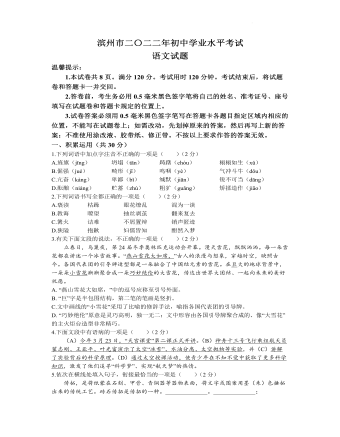
2022年山东省滨州市中考语文真题
【甲】大道之行也,天下为公。选贤与能,讲信修睦。故人不独亲其亲,不独子其子,使老有所终,壮有所用,幼有所长,矜、寡、孤、独、废疾者皆有所养,男有分,女有归。货恶其弃于地也,不必藏于己;力恶其不出于身也,不必为己。是故谋闭而不兴,盗窃乱贼而不作,故外户而不闭。是谓大同。
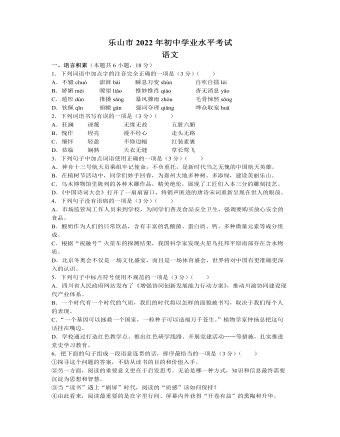
2022年四川省乐山市中考语文真题
中华民族拥有5000多年灿烂文明。弘扬中华美育精神,用美育涵养“美丽心灵”,不妨从教育引导年轻人热爱艺术开始。年轻人通过认识和理解中华大地上的优秀艺术作品,可以形成开阔的视野和包容的心态,增强文化自觉和文化自信。引导年轻人接近、欣赏中国文艺作品之美,有助于赓续优秀文化传统,增强做中国人的志气、骨气、底气。
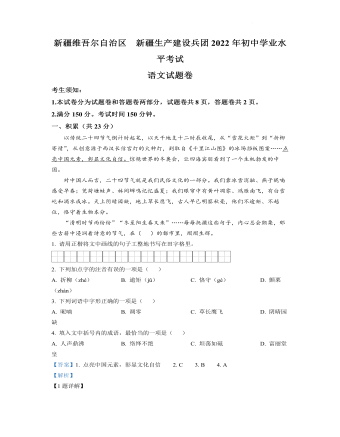
2022年新疆中考语文真题(解析版)
尊敬的李教授:我校读书节活动将于4月25日在图书馆拉开帷幕。读书节期间,①学校将开展征文比赛、读书交流会、课本剧表演等。②您对名著阅读的研究确实有点水平,学校③特邀您开设《傅雷家书》阅读方法专题讲座,请您百忙之中参加为盼!
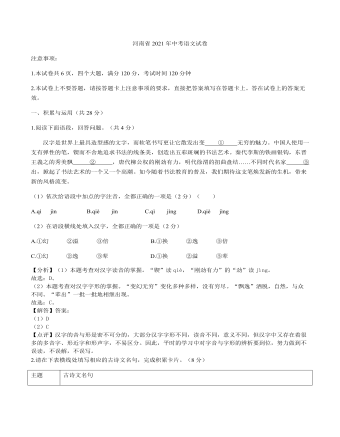
2021年河南省中考语文真题(解析版)
班长立刻组织抢修舵链,这才发现,几乎不可能。修舵链要从船头的铁柱处下去,可甲板到船头的舱盖上结了厚冰,舱盖是拱形的,十多米长。平时,船一晃,在上面走都很难。现在结了冰,站都站不住,根本别想走过去。班长看着结冰的舱盖请示陪同的马参谋长:“参谋长,过不过?”“怎么过?”“爬!”“多大把握?”“没有。”马参谋长认真看了看班长,重重拍了他一下。
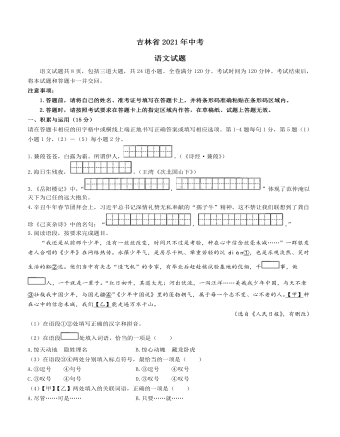
2021年吉林省中考语文真题(答案版)
出佛手园,远处有山,山中有岚,有云。岚清,云白,绸缎一般,棉花一般,曼妙而行,逍遥自在。除了爱,还有眼前这山川草木。小小人类身处自然,永不孤单。那些草木,那些动物,那些自然界中的生灵,各安其所,相处自洽。而人类,不免焦虑,屡屡焦虑,内在小宇宙紊乱,何不走到自然中,谦卑蹲下,去学习一株草、一颗露珠的宁静?
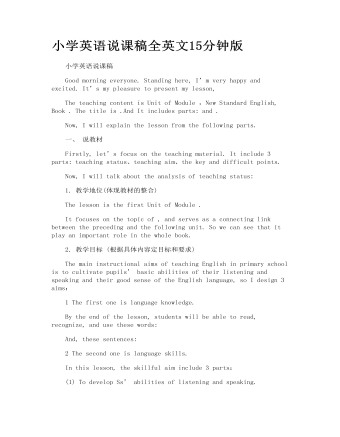
小学英语说课稿全英文15分钟版
一、 说教材 Firstly, let’s focus on theteaching material. It include 3 parts: teaching status、teachingaim、the key and difficult points. Now, I will talk about the analysis of teaching status: 1. 教学地位(体现教材的整合) The lesson is the first Unit of Module . It focuses on the topic of , and serves as a connectinglink between the preceding and the following unit. So we can see that it playan important role in the whole book. 2. 教学目标 (根据具体内容定目标和要求) The main instructional aims of teaching English inprimary school is to cultivate pupils’ basic abilitiesof their listening and speaking and their good sense of the English language,so I design 3 aims:
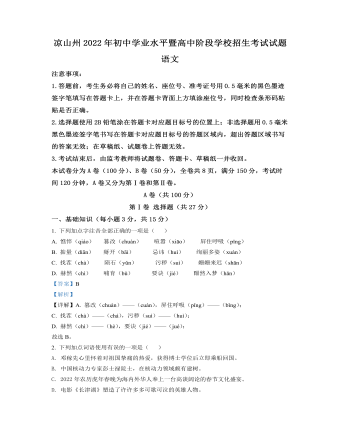
2022年四川省凉山州中考语文真题(解析版)
5000多年源远流长的文明历史中,中华民族始终有着“自古英雄出少年”的传统,始终有着“长江后浪推前浪”的情怀。一百年前,共青团成立之际,一大批先进青年在“觉醒年代”纷纷觉醒。新时代建设中,哪里有需要,哪里就有青年的身影:在抢险救灾前线冲锋陷阵,在疫情防控一线披甲出征,在平凡的岗位上兢兢业业,在美丽的校园里不懈奋斗……“清澈的爱,只为中国”,成为当代中国青年发自内心的最强音。
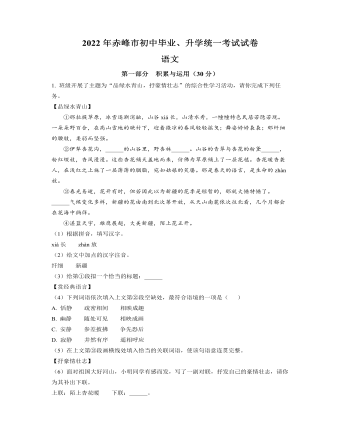
2022年内蒙古赤峰市中考语文真题(解析版)
题稚川山水【唐】戴叔伦松下茅亭五月凉,汀沙云树晚苍苍。行人无限秋风思,隔水青山似故乡。注:戴叔伦,唐代诗人,此诗作于作者宦游途中。
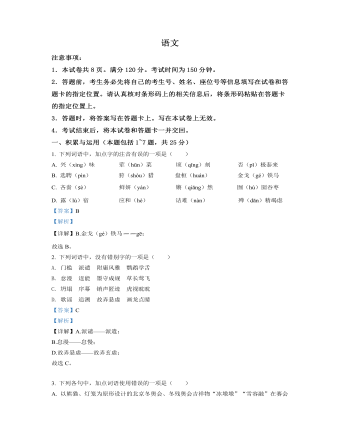
2022年内蒙古包头市中考语文真题(解析版)
夜来似闻某人素心,明日试往看之,入其门,窥其闺,见所谓某人方据案面南看一文书。顾客入来,默然一揖,便拉袖命坐,曰:“君既来,可亦试看此书。”相与欢笑。日影尽去,既已自饥,徐问客曰:“君亦饥耶?”不亦快哉!
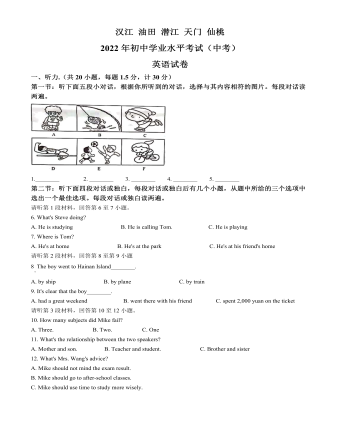
2022年湖北省江汉油田、潜江、天门、仙桃中考英语真题(解析版)
Penny’s family was very poor. Her father was asailor (水手).He earned very little money and was ____16____ away from home. Her mothercould not work ____17____she was often sick. One day.
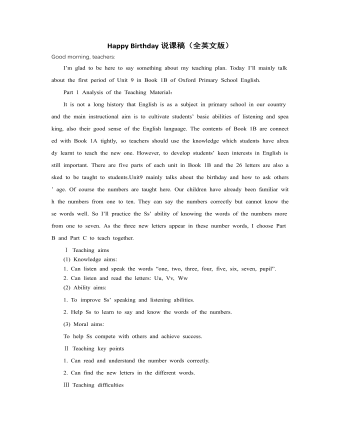
人教版新课标PEP小学英语三年级上册Happy Birthday(全英文版)说课稿
1. Do some exercise on the paper. There are four kinds of exercise here. The exercise 1 is to develop Ss’ ability of listening. Exercise 2 is to practice Ss’ ability of knowing the words. Exercise 3 is to develop Ss’ ability of speaking numbers and letters. Exercise 4 is to make Ss know the words and letters well. These exercises can consolidate the new knowledge from different styles of problems.2. Then tell Ss that we can sing the numbers like “ Do, re, mi, fa, so, la, ti, do” and let them listen to a song named “Do, Re, Mi”. Add some extra knowledge so that Ss will be glad to see that the numbers can be used in another way.Step 4 Homework1.Read the numbers from 1 to 7 and 7 to 1 five times.2.Read the letters “u, v, w” five times follow the tape.Reading is a useful way for the Ss of Grade One to practice the knowledge. Ask Ss to imitate reading from the tape in order to make Ss have a good habit of listening and let them have a better pronunciation.Step 5 Board writingI ‘ll put the seven numbers like a scale(音阶)as I’ll let Ss know that we can sing out the numbers. When it comes to listen to the song, I ‘ll draw a musical note on Bb. Unit 9 Happy birthday!sevensixfivefourthree U u V v W wtwo pupil five windowoneThat’s all for my class designing. Thank you for listening!
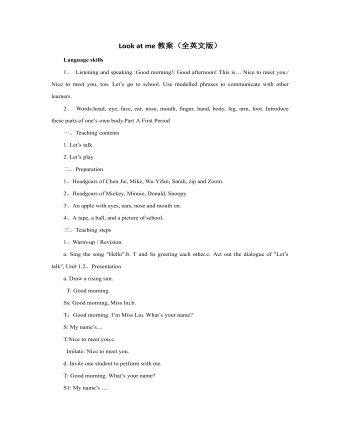
人教版新课标PEP小学英语三年级上册Look at me教案(全英文版)
3、Practicea. Nice to meet you. Nice to meet you,too.b. Perform the dialogue.c. Arrange the dialogue according to the pictures or sentence cards.d. Let’s play.A: Good afternoon,B. This is C. Hello, C! Nice to meet you.C: Nice to meet you, too.A,B: Goodbye!C: Bye!4、Assessment Workbook page 10Add-activitiesa. Listen to the recording and repeat.b. Make a dialogue according to "Let’s talk".Second Period一、Teaching contents1. Let’s learn Words:body, leg, arm, hand, finger, foot.1. Let’s do二、Preparation1、a puppet2、Cards of body, leg, arm, hand, finger and foot.3、headgear of a captain三、Teaching steps1、Warm-up/ Revisiona. Captain says to review "let’s do" of Part A.b. Perform the students their own dialogues.2、Presentationa. Learn to say "body, leg, arm, hand, finger and foot."b. Listen to the recording and repeat.c. Let’s do. Clap your hands. Snap your fingers. Wave your arms. Cross your legs. Shake your body. Stamp your foot.3、Practicea. Let’s draw a person.b. Let’s do. Point out which picture.c. Let’s do. Who responses faster.4、Assessment Workbook page 115、Add-activitiesa. Listen to the recording, repeat and act out.b. Say all the names of the body to your parents.Third Period一、Teaching contents1. Let’s check2. Let’s chant二、Preparation1、stationeries1、pictures of parts of Zoom
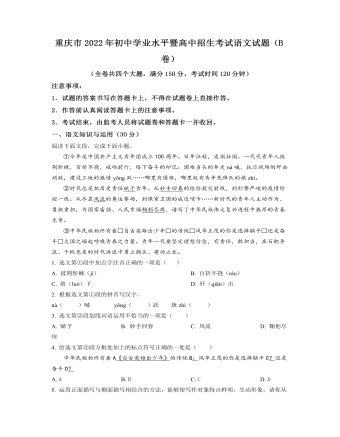
2022年重庆市中考语文试卷(B)及答案
在厨房蒸馒头的母亲,揭开锅盖高兴地说到:“馒头笑了。”我没看出来,就问她怎么笑的。母亲说:“就是馒头开口了,过年了,讨个吉利,所以要说笑了才行。”
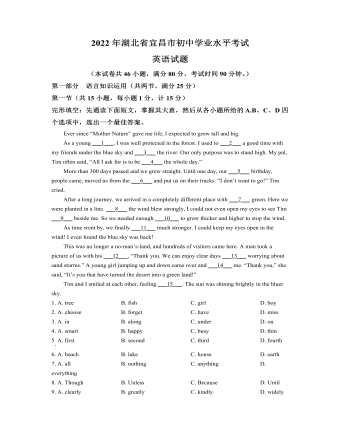
2022年湖北省宜昌市中考英语试题(解析版)
Duringwork hours in Becker’s bread shop, the kitchen is especially quiet except thesound of the machine. The quiet environment is not the result of the strictrules, but because all the workers are deaf. They use sign language tocommunicate with each other from time to time.
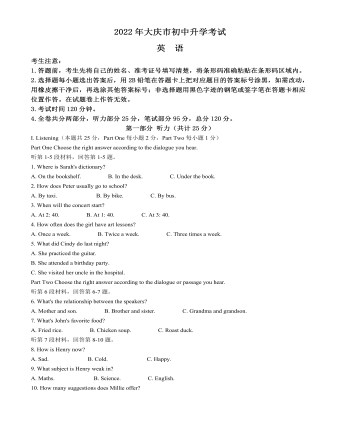
2022年黑龙江省大庆市中考英语试题(解析版)
On a snowy day, there was a man walking in ahurry on the road. His clothes were in poor condition. You might think he was abeggar(乞丐),but in fact he was a painter. His name was Vincent Willem van Gogh.
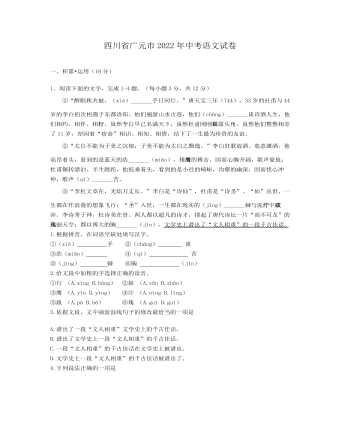
2022年四川省广元市中考语文试卷及答案
予谓菊,花之隐逸者也;牡丹,花之富贵者也;莲,花之君子者也。噫!菊之爱,陶后鲜有闻。莲之爱,同予者何人?牡丹之爱,宜乎众矣。
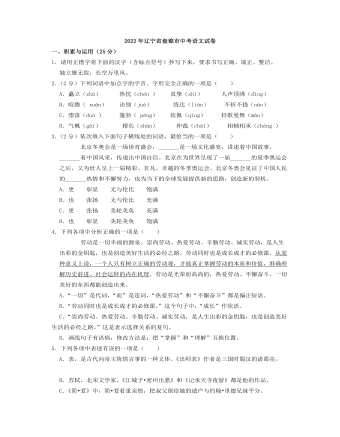
2022年辽宁省盘锦市中考语文真题及答案
①我妈是一个知青,我爸是一个农民。在我幼时的岁月里,我爸应该很辛苦。只有他一个农村户口,却有三个城里人要养活,他的田地太少了。但他勤快,愿意为生活付出所有气力。据说我家永远是每亩地里出钱最多的人家,而他的女儿们却几乎没去过那片土地。
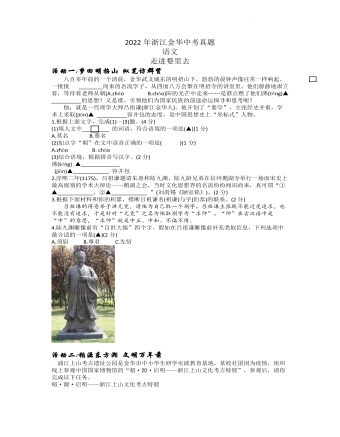
2022年浙江省金华市中考语文真题及答案
“幸好!”妈妈笑道,“走出五里路我就哭了,一哭哭了几百里……”常乐想问为什么,忽然响起一片古怪的声音。满池塘都在怪叫。常乐像皮球一样弹到妈妈怀里,大叫:“水里有怪物!”
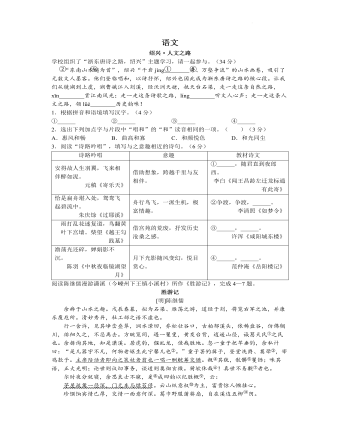
2022年浙江省绍兴市中考语文真题及答案
一只蜉蝣从水里一点一点钻出来。远远的天边,一个红红的家伙一点一点冒上来。蜉蝣高兴地和它打招呼:“你好,你很神奇呀,你一来世界就亮了。”“你好,小蜉蝣。”“你认识我?你是谁呀?”“我是太阳。”“太阳,我好快乐呀,我有一天的生命,你和我一样吗?”
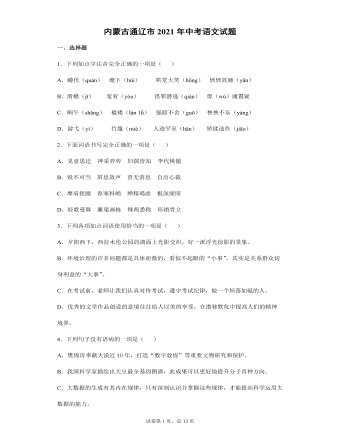
2021年内蒙古通辽市中考语文真题(解析版)
妈妈19岁嫁给爸爸。外婆生育了6个孩子,还领养了一个,但妈妈是唯一的女儿,在那个年代,虽然说不上能享受到多少宠爱,但至少没有遭受过任何对女性的轻慢,妈妈甚至还念到初中毕业,字写得比我还好,能自由阅读文学作品。





















